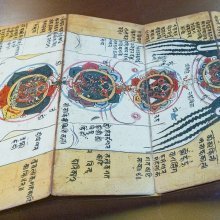Nostril: 2 definitions
Introduction:
Nostril means something in Hinduism, Sanskrit, the history of ancient India. If you want to know the exact meaning, history, etymology or English translation of this term then check out the descriptions on this page. Add your comment or reference to a book if you want to contribute to this summary article.
Images (photo gallery)
In Hinduism
Yoga (school of philosophy)
Source: ORA: Amanaska (king of all yogas): A Critical Edition and Annotated Translation by Jason BirchThe Nostrils are denoted by the Sanskrit term Nāsikā-Puṭa, according to the Pātañjalayogaśāstra (i.e., the Yoga Sūtras of Patañjali) 1.34.—Accordingly, while discussing Prāṇāyāma and Samādhi: “Or [stability of mind is attained] through exhalation and retention of the breath”.—[Commentary]—“Exhalation is the emission of the abdominal breath through the nostrils (nāsikāpuṭa) with particular care, and retention is stopping the breath. Through both [of these], one should accomplish stability of mind”.

Yoga is originally considered a branch of Hindu philosophy (astika), but both ancient and modern Yoga combine the physical, mental and spiritual. Yoga teaches various physical techniques also known as āsanas (postures), used for various purposes (eg., meditation, contemplation, relaxation).
India history and geography
Source: Singhi Jain Series: Ratnaprabha-suri’s Kuvalayamala-katha (history)Nostrils (of bullocks) (being pierced) represents a scene of human life commonly depicted on the Saṃsāracakra paintings in ancient India, as mentioned in the Kathās (narrative poems) such as Uddyotanasūri in his 8th-century Kuvalayamālā (a Prakrit Campū, similar to Kāvya poetry).—Page 185.21 f.: Here follows a description of a printed scroll illustrating the Jaina conception of saṃsāracakra. [...] The saṃsāra-cakra illustrated the three worlds of hell, human world and the world of gods. [For example:] the agriculturists engaged in ploughing their field with plough, bullocks with pierced nostrils and with ropes tied round their necks, having ploughs on their necks, and bleeding owing to their having been pricked with sharp pointed whips.

The history of India traces the identification of countries, villages, towns and other regions of India, as well as mythology, zoology, royal dynasties, rulers, tribes, local festivities and traditions and regional languages. Ancient India enjoyed religious freedom and encourages the path of Dharma, a concept common to Buddhism, Hinduism, and Jainism.
See also (Relevant definitions)
Full-text (+246): Nasaputa, Nasashosha, Nasarandhra, Pranayama, Pautinasikya, Kumbhaka, Putinasya, Puraka, Ghona, Protha, Svarashastra, Nakapudi, Nasika, Nasya, Ghranaputaka, Ucchinghana, Nasavivara, Nasanaha, Shvasanarandhra, Nasikaputa.
Relevant text
Search found 167 books and stories containing Nostril; (plurals include: Nostrils). You can also click to the full overview containing English textual excerpts. Below are direct links for the most relevant articles:
The Garuda Purana (by Manmatha Nath Dutt)
Chapter CCXXV - The Pavana Vijaya < [Dhanvantari Samhita]
Chapter LXVII - The science of Pavana Vijaya (conquest of breath) < [Agastya Samhita]
Chapter XX - Mantra-cures (curative formulas) of snakebite as narrated by Shiva < [Agastya Samhita]
Puranic encyclopaedia (by Vettam Mani)
Thirty minor Upanishads (by K. Narayanasvami Aiyar)
Yoga-kundalini Upanishad of Krishna-Yajurveda, Chapter I
Shandilya Upanishad of Atharvaveda, Chapter I
The Great Chariot (by Longchenpa)
Part 3b.1 - Shamatha: Taming discursive thoughts < [B. The gradation of powers of those who meditate into high, middle, and low]
The Skanda Purana (by G. V. Tagare)
Chapter 199 - The Greatness of Āśvina Tīrtha < [Section 3 - Revā-khaṇḍa]
Chapter 42 - Means of Dodging Kāla < [Section 1 - Pūrvārdha]
Chapter 201 - Greatness of Kālabhairava Śmaśāna < [Section 1 - Prabhāsa-kṣetra-māhātmya]
Yoga-sutras (with Bhoja’s Rajamartanda) (by Rajendralala Mitra)
Sūtra 2.32 < [Second Chapter (Sadhana Pada)]
Sūtra 1.34 < [First Chapter (Samadhi Pada)]
Sūtra 2.46 < [Second Chapter (Sadhana Pada)]
Related products


